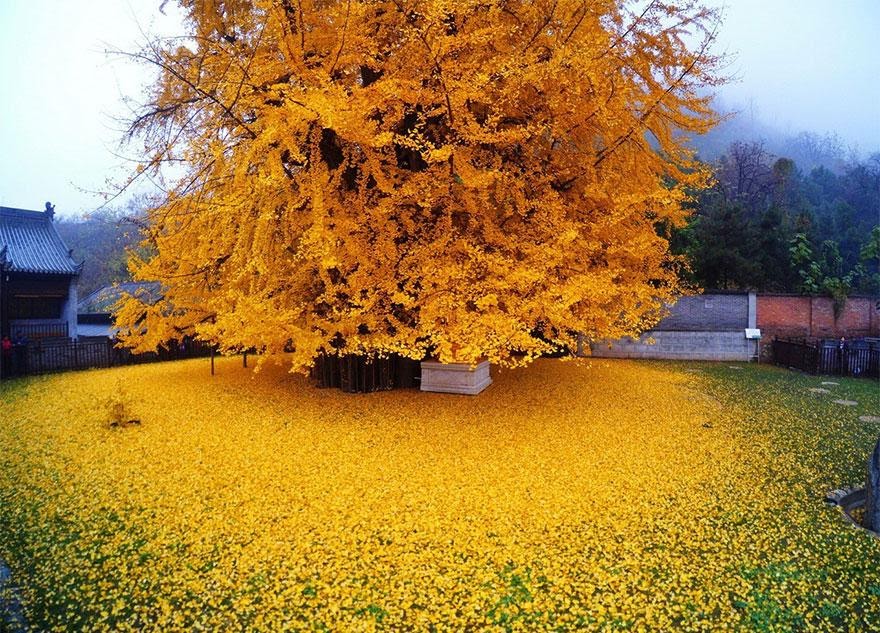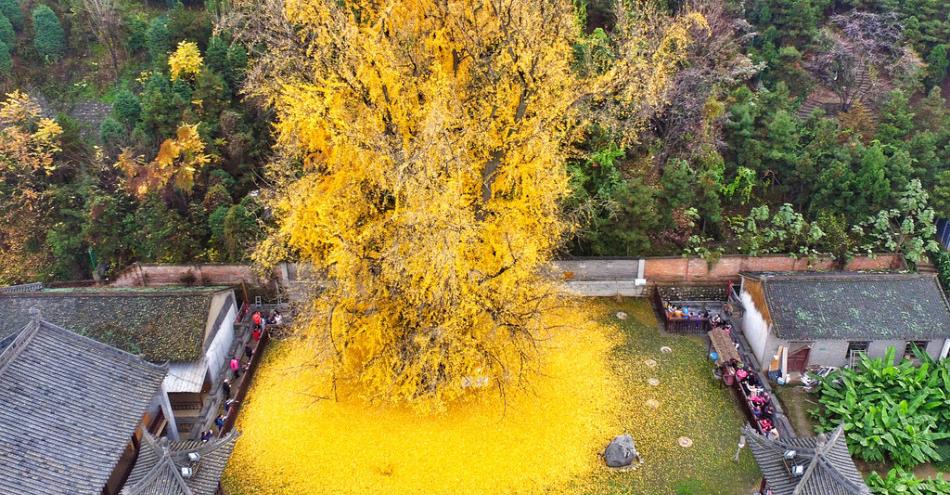The oldest surviving tree species on Earth, older than dinosaurs. The mighty Ginkgo Tree.
Trees are some of nature’s most beautiful creations, endlessly giving out so much life and protection for as long as they live – usually a very long time. If regular trees with green leaves can add so much beauty to nature, imagine a tree that sheds an incredible lake of golden leaves every autumn. A stunning ginkgo tree is located at the Gu Guanyin Buddhist Temple in China’s province of Shaanxi. This tree is 1,400 years old and is one of China’s most important tourist attractions.
Starting in November, during China’s autumn season, the green, fan-shaped leaves of the tree turn a stunning bright golden-yellow color and fall to the ground in a mini ocean of enthralling beauty [1]. The sight is so captivating that several local monks can be seen regularly meditating below the tree.

The Ginkgo Tree, a Sparkling Wonder with a Rich Heritage
The ginkgo tree (Ginkgo biloba) is the only living species in the division Ginkgophyta. Native to China, the Ginkgo tree is also called “the maidenhair tree” due to its rich spectacle of golden color in the autumn.
Sometimes referred to as “living fossils,” extinct ginkgo species can be found in fossils from over 270 million years ago. Ginkgos are the oldest surviving tree species on Earth, older than dinosaurs, and there is evidence that humans planted them in the earliest times of our history. The Gingko is remarkably resilient to climate change and hasn’t evolved in over 200 million years. They are relatively common in China and some other parts of Asia.
However, this particular tree in the Buddhist temple is the oldest Ginkgo tree in Asia, still very much alive after a remarkable 1,400 years. This is a sharp contrast from most other Ginkgo trees, which generally live 50-400 years. Thus, this unique tree represents longevity and unending wellness. Some people believe that the prayers said to Buddha in the temple are responsible for the tree’s immortality.
However, the temple’s management explained that the tree has a spring running beneath it, a major contributor to its eternal growth [2].

It has a rich history dating back to the Tang Dynasty (618-907), where it is said to have been planted by the founding father, Emperor Li Shimin. The leaves are claimed to be used to treat a wide array of illnesses in traditional Eastern medicine, such as reduced blood circulation, cognitive disorder, dementia, altitude sickness, and sexual dysfunction [3].
However, one problem with the ginkgo trees is that their leaves are unpleasantly scented, especially when they begin to rot. Nonetheless, this doesn’t stop people from pouring into the temple in large numbers to see the tree every year.
Read: Vikings were in North America in 1021, well before Columbus, researchers say
Tens of thousands of yearly visitors
Within a space of 20 days, when the golden leaves begin to fall, the temple allows not more than 3,000 visitors from all over the world to see the tree each day. They expect about 60,000 tree-lovers a year. Reservations are needed to visit the temple.
The tree originally went viral and made its rounds on social media in 2015. Some comments from Twitter:
@MrBeardsless @visualgasm right?? The contrast between the colors. Life is beautiful. I need to explore and travel as much as possible.
— ENEA (@Only_Enea) November 28, 2015
Some people were thinking outside the box:
There must be one pissed off neighbour doing a great job sweeping the leaves that drop over the fence on the left.
— Saint Chester (@StChester) December 7, 2017
Others just loved the amazing photography:
the overhead shot is incredible!
— Kevin Faigle (@kevinfaiglewrdw) December 7, 2017
Keep Reading: Ancient tree tells chaotic tale of Earth’s magnetic field reversal
Sources
- “This Buddhist temple’s 1,400-year-old ginkgo tree is dropping a sea of yellow.” Independent. Christopher Hooton. November 26, 2015
- ” An ocean of golden leaves: 1,400-year-old Ginkgo tree planted in a temple by a Chinese emperor stuns the internet with its breath-taking autumn foliage.” Daily Mail. Chloe Lyme and Tracy You. November 14, 2019.
- “GINKGO BILOBA.” RX List. Admin.
- “The Life Story of The Oldest Tree on Earth.” Yale Environment 360. Roger Cohn. May 1, 2013.

